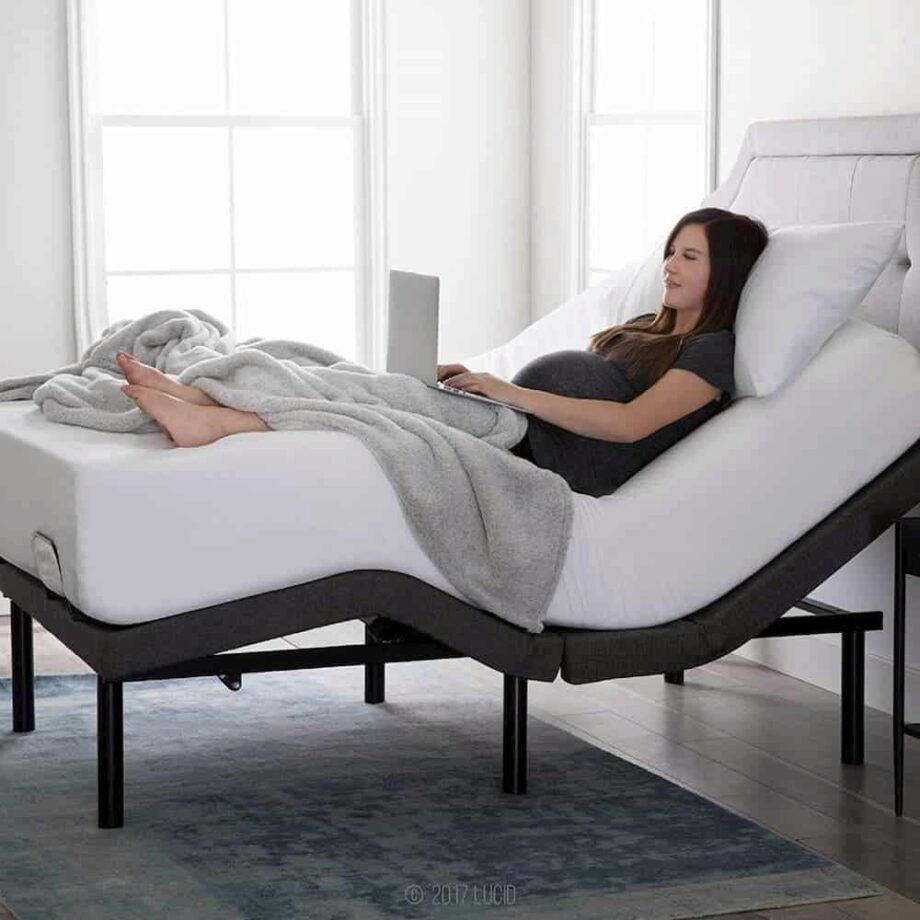The Best Adjustable Bed Setting For All Sleepers
Disclosure: By clicking on the product links in this article, Mattress Nerd may receive a commission fee at no cost to you, the reader. Read full disclosure statement.
There are a lot of reasons people buy adjustable beds. Some people use them to help them find a position that eases the strain of chronic aches and pains. For others, especially younger generations, adjustable beds have become places of work or leisure — for working on your laptop, watching TV, or even eating dinner.
Because of their comfort and versatility, more and more people are buying, or considering buying, an adjustable bed. According to the International Sleep Products Association’s 2018 Mattress Industry Trends Report, unit sales of adjustable beds grew nearly 30% during the first quarter of the year compared to the same time the previous year.
Adjustable beds involve bed frames or bases that raise and lower the head and/or foot of the bed. They come in a variety of sizes and price points. Most are compatible with memory foam, latex, or air mattresses. And, thanks to new technology, some offer added features such as USB ports, massage controls, zero gravity presets, and smartphone pairing.
Whether you have had an adjustable bed for years, just bought one, or are considering buying one in the near future, we have some suggestions for how to get the most out of your bed’s settings depending on your lifestyle and sleeping concerns.
Head Raised Positions

Who Is This Position Good For?
People Who Snore
If you sleep with a partner, snoring can be very disruptive to them, but it can also interfere with your sleep. It can also put you at increased risk for sleep apnea, a potentially dangerous condition during which snoring is accompanied by moments when you stop breathing due to airway obstruction.
The sawing logs sound of snoring happens when your tongue falls to the back of your throat while you’re sleeping and blocks your windpipe. As you struggle to breathe through this slight obstruction, it causes the tissues in your throat to vibrate and make noise.
Pushing the snorer onto their side may help. however, for lasting relief, the best remedy is to slightly raise the head and neck of the snorer at least 20 to 30 degrees. This prevents the tongue from falling back into the throat where it blocks the airway and causes noisy snoring.
Sleepers with Sleep Apnea
Sleep apnea, often called obstructive sleep apnea, is caused when the tissues of the throat fall back and obstruct the windpipe. While many sufferers of sleep apnea also snore, the big difference is that with sleep apnea, the snoring is interrupted by pauses during which breathing stops. This is due to the airway has collapsed, triggering the sleeper to choke or gasp. Bouts of sleep apnea can happen hundreds of times during the night and can last for a minute or longer.
The sleeper is usually isn’t aware that they have stopped breathing during the night. However, because sleep apnea disrupts restful sleep, these episodes can interfere with restorative sleep, leaving you groggy the next day. Sleep apnea can be life-threatening, especially if it causes the oxygen levels in the blood to drop.
Sleep apnea is often treated with a CPAP machine, consisting of a hose and a mask or nose piece that delivers constant and steady air pressure. The masks and nose pieces can feel bulky and uncomfortable, making it difficult for you to fall asleep. You may also wake with a stuffy nose or dry mouth.
Elevating the head of your bed works well in tandem with CPAP therapy, helping to open airways in the throat and reduce episodes of sleep apnea. Adjustable beds can be so effective at keeping the sleeper’s torso upright, the beds may also eliminate the need for a CPAP altogether. Be sure to discuss with your doctor before stopping or adjusting your CPAP therapy.
Sleepers with Acid Reflux
Acid reflux is an unpleasant condition in which stomach acid flows back up the esophagus. This can cause irritation, inflammation, and heartburn pain. Over time, this backflow of acid can cause swallowing difficulties; painful, bleeding sores or ulcers; or a precancerous condition called Barrett’s esophagus.
Even with a prescription or over-the-counter acid reducers, acid reflux gets worse at bedtime because lying down allows acid to creep up the esophagus. This is when raising the head of an adjustable bed becomes a game-changer.
The stomach and esophagus intersect around the location of the lower part of the shoulder blades. This means that for optimal acid reflux relief you’ll want to elevate the head, neck, as well as shoulder blades. Using multiple pillows to raise the head and torso is not recommended because doing so can prop the head at an angle that compresses the stomach. This will further aggravate and worsen acid reflux.
Some studies suggest that six to eight inches are the optimal height the head of the bed should be raised to reduce or eliminate acid reflux. But some esophageal experts say that in actuality, the higher the head is elevated, the better. The only problem is that a fully upright position may be uncomfortable to sleep in.
Feet Raised Positions
Who Is This Position Good For?
People with Lower Back Pain or Sciatica Pain
About 31 million people experience lower back pain, according to the American Chiropractic Association. In fact, it’s the single leading cause of disability, costing Americans at least $50 billion in annual health care costs. Sleeping with an aching back or sciatica (pain along the sciatic nerve, which radiates down one or both legs from the lower back), can leave you tossing and turning at night in search of a comfortable sleeping position.
Elevating the legs and bending the knees while lying on your back can help relieve back and sciatica pain. This takes the pressure off the lower spine and the sciatic nerve by rotating the pelvis and flattening the spine against the mattress. Putting a pillow under the knees can provide some relief for minor pain. But if your pain is severe, then you may want to raise the legs higher. Pillows won’t provide the support and stability you will get from an adjustable bed.
People with Poor Circulation
Several health issues can cause poor circulation, including obesity, high blood pressure, high cholesterol, diabetes, varicose veins, and peripheral vascular disease, a condition that restricts normal blood flow to and from the heart. Circulation issues can cause symptoms such as numbness and tingling in the extremities, cold hands and feet, swelling in the lower extremities, joint pain, and muscle cramps.
Lying with your legs elevated at least six inches above the heart helps the natural flow of your blood through the body. That’s because the veins don’t have to make any extra effort to flow against gravity as it travels back to your heart, as it does while you are standing. For best results, try tilting legs about 45 degrees with the knees slightly bent. Rotate your feet and ankles, and flex and release your calf muscles while in this position to help promote blood circulation.
People with edema/swelling in the feet or legs
Edema is swelling caused by excess fluid in the body’s tissues. This can be caused by medications, pregnancy, infection, or other medical problems, and can happen almost anywhere in the body. Edema is typically seen in the legs, feet, and ankles, and may be a symptom of a medical issue with the circulatory system, lymph nodes, or kidneys.
Lymphedema is a type of edema that is caused by damage to the lymphatic system, which is the system that filters germs and waste from the body. Lymphatic damage can be caused by radiation, surgery, or another physical injury. Or, it can be heredity. Lymphedema is most often seen in one or both legs.
Elevating the legs above the heart several times a day allows gravity to drain and, as a result, can decrease swelling and pain. Some doctors advise patients to sleep in this position, if possible. For best results, lie flat on your back and tilt your thighs to just less than a 45-degree angle. Then, bend your knees to between 20 to 30 degrees to limit pressure on your tendons. Finally, tilt your calves between 15 and 20 degrees
Head and Feet Raised Positions

Who is this Position Good For?
People with Mobility Issues
Mobility issues are common, especially among older adults. But even younger people can experience difficulty walking and moving due to low physical activity, obesity, impaired strength, and balance, or chronic diseases such as diabetes and arthritis. Sleeping with both the head and feet raised, cradled in the fetal position, offers tremendous benefits for people who have mobility issues.
Raising both the head and the feet can simultaneously alleviate issues like acid reflux or breathing issues while also helping with poor circulation or general aches and pains due to edema, arthritis, or restless leg syndrome.
Another benefit that adjustable beds offer for those with mobility issues is a caregiver who is better equipped to care for their needs. Those who care for people with mobility issues can raise the bed to a height that is easier to reach, lessening the strain on the caregiver’s back. However, don’t think that you have to have a disability to reap the benefits of being cradled in the fetal position. According to the National Sleep Foundation, sleeping with both the head and legs curved toward each other ease lower back pain and reduces snoring, enabling you to sleep sounder and wake feeling ready to tackle the day ahead.
People with Asthma or COPD
More than 25 million adults and children suffer from asthma, a condition that intermittently inflames and narrows the airways in the lungs. Another 16 million adults have COPD (chronic obstructive pulmonary disease), an inflammatory lung disease that causes obstructed airflow from the lungs.
People who suffer from chronic lung diseases, such as these often experience more difficulty breathing when they lie down. This can make sleeping a challenge. As a result, many people with these issues tend to sleep in recliners with both their heads and legs elevated.
Adjustable beds allow these individuals to sleep in their own bedrooms instead of the living room where their reclines are located. They also offer far more comfort than a recliner, and ensure a better night’s sleep.
Contouring & Custom Firmness

Who is this Position Good For?
People with Arthritis
Arthritis is a painful and sometimes debilitating inflammation of the joints that affects an estimated 22.7% of Americans. There are more than 100 different types of arthritis, the most common being osteoarthritis, and rheumatoid arthritis.
People who suffer from arthritis have a difficult time finding relief from their pain, especially when they sleep. And they often wake with stiff, aching joints. Adjustable beds offer arthritis sufferers a unique therapeutic option — zero gravity.
The zero-gravity position on adjustable beds elevates the legs higher than the head, simulating weightlessness. This position evenly distributes the weight while the body and muscles are in a relaxed state. It also enhances pressure relief allowing for better blood flow to the brain and through the body.
For added comfort, people who deal with arthritis pain may find greater benefit with their adjustable bed with a mattress firm enough to provide support but with enough pressure-relieving cushion to cradle the hips and shoulders.
Split Adjustable Beds

Who is this Position Good For?
Elderly Couples
Split adjustable beds are great options for couples who want to customize their bed position to their own specific needs. While this is a great option for any couple, it can be especially helpful for older adults who have health concerns that benefit from different adjustable bed positions.
Split adjustable beds come in king or California king, which offers each sleeper maximum room as well as comfort. Motorized bases also make adjustments easy.
Conclusion
Adjustable beds have come a long way since they hit the market decades ago as medical equipment for the infirm. Now, they turn bedrooms into comfortable places for work or leisure activities, while providing customizable positioning for improved sleep so you can get a good night’s rest.
Whether you have an adjustable bed or are considering buying one, you’ll want to investigate your position options based on your lifestyle or sleeping concerns in order to get the most out of your investment.


